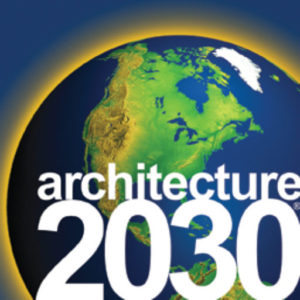Successes in 2007
It’s Been A Great Year!
Congratulations are in order for all of you who have helped us at Architecture 2030 get our message out. We’re looking forward to the challenges and opportunities of the New Year. We want to take this opportunity to thank you for your support. Have a wonderful holiday season!
PBS e2: Architecture 2030
The half-hour PBS series e2–design, which features Architecture 2030, begins on December 28, 2007. e2–design (the economies of being environmentally conscious) is a six–part series that explores the vitality of the environment through architecture. Narrated by Brad Pitt, the Architecture 2030 episode introduces Edward Mazria, The 2030 Challenge and the drive to address today’s most pressing issue, climate change.
UCTV Features Mazria Lecture, Global Warming: Nation Under Siege
UCTV will feature Edward Mazria’s keynote talk, Nation Under Siege, delivered at the University of California San Diego, on October 29, 2007. The talk will air from January 21, 2008 through January 27, 2008.
ARCHITECTURE 2030 – Year in Review Highlights
This has been a very productive year for Architecture 2030 and The 2030 Challenge. First cities, then states, and just last week, the feds have taken up the Challenge targets. The following highlights the progress made in 2007:
- February – The 2010 Imperative: Global Emergency Teach–in
A quarter million people from 47 countries gathered on February 20, 2007 to participate in The 2010 Imperative: A Global Emergency Teach–in. During this live interactive webcast, Architecture 2030 issued The 2030 Challenge and The 2010 Imperative, specific achievable strategies to transform the built environment. - May – The 2030 Challenge Benchmark Set
The American Institute of Architects (AIA), the American Society of Heating, Refrigerating and Air–Conditioning Engineers (ASHRAE), Architecture 2030, the Illuminating Engineering Society of North America (IESNA), and the U.S. Green Building Council (USGBC), supported by representatives of the US Department of Energy, finalized an agreement of understanding, establishing a common starting point (benchmark) and a goal of net zero energy buildings. - June – The State of Illinois Adopts The 2030 Challenge
The State of Illinois legislature voted for final passage of Senate Joint Resolution 27, adopting the 2030 Challenge for all state buildings. - August – City of Vancouver Adopts The 2030 Challenge
The City of Vancouver adopted The 2030 Challenge target of carbon–neutral buildings by 2030. - September – Nation Under Siege: Sea Level Rise at Our Doorstep
Architecture 2030’s landmark sea level rise study published. In stunning graphics, the study projects that beginning with just one meter of sea level rise, the US would be physically under siege, with calamitous and destabilizing consequences. - September – California Public Utilities Commission Adopts 2030 Targets
California Public Utilities Commission officials set a goal of building only “zero net energy” homes by 2020 and only commercial buildings that require no outside energy by 2030. - September – “Think You’re Making a Difference?”, New Yorker Magazine
Architecture 2030 places an informative full–page ad in New Yorker magazine, regarding the US Building Sector and coal-fired power plants. New Yorker magazine distributes 1,500 copies of the study “Nation Under Siege” to its Hot List. - September – “Want to Stop Global Warming?”, New York Times
Architecture 2030 places an informative full–page ad in the New York Times, outlining the critical global warming issues and the steps necessary to prevent dangerous climate change. - October – Richmond, VA, Adopts 2030 Challenge
Mayor L. Douglas Wilder announced October 3 that his City of Richmond, Va., had adopted the 2030 Challenge with the intent of making the capital of that commonwealth carbon neutral by the year 2030. - October – Santa Barbara Approves Architecture 2030 Energy Ordinance
A glowing Santa Barbara City Council unanimously approved the Architecture 2030 Energy Ordinance, legislation that, if approved by the California Energy Commission, will give Santa Barbara some of the most stringent environmental building standards in the state. - November / December – “America: Nowhere To Hide”, NY Times, Roll Call and BusinessWeek
Architecture 2030 puts a richly–illustrated full–page ad in the New York Times, Roll Call and BusinessWeek, outlining the vulnerability of US coastal cities and towns to small increments of sea level rise. - December – California Energy Commission Adopts The 2030 Challenge Benchmark
Energy–efficiency goals adopted by the California Energy Commission should make all new homes so energy–efficient by 2020 that they won’t need to draw power from the state’s electrical grid, according to a plan for meeting the state’s future energy needs…. The plan calls for applying the same standard to commercial buildings by 2030. - December – President Signs Energy Bill Containing The 2030 Challenge Targets
After being passed by the Senate and the House of Representatives, the Energy Independence and Security Act became law with the President’s signature. Section 433 of this bill requires that all federal buildings meet the energy performance standards of The 2030 Challenge.




